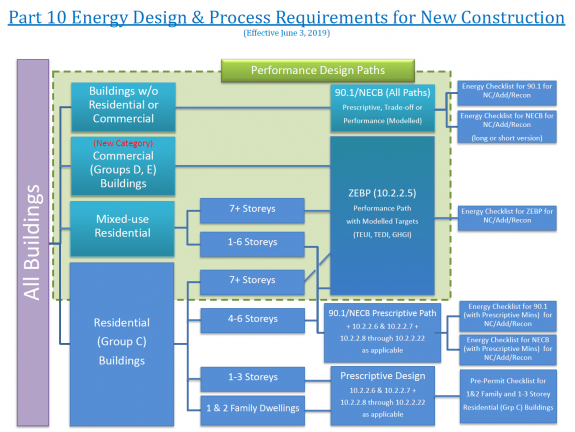Updates have been made to Section 10.2 “Energy Efficiency” of the Vancouver Building By-Law (VBBL) 2019. The changes are effective for Building Permit applications received on and after June 1, 2021.
Introduction to Section 10.2
Section 10.2 of the VBBL 2019 outlines the Energy Efficiency requirements for building projects located in Vancouver BC.
Depending on the building occupancy, there are prescriptive and performance design pathways available. These pathways offer some options to project teams as outlined in the following image.

Multi-unit residential and commercial building types are required to comply with Section 10.2.2.5 which outline the Zero Emissions Building Plan – Performance Limits. The are three energy metrics for which performance limits have been established:
- Total Energy Use Intensity (TEUI)
- Thermal Energy Demand Intensity (TEDI)
- Greenhouse Gas Emission Intensity (GHGI)
These terms are defined at the end of this article.
Updates
As part of City of Vancouver’s Zero Emission Building Plan, the performance limits will be reduced to achieve zero emission building design by 2030. The recent updates reflect this plan and are a huge step towards achieving the City’s goals.
The updated performance metrics will also align with Step 3 of the BC Energy Step Code. Aligning the VBBL targets with the Step Code should aid with clarity in the industry moving forward.
The updated VBBL document can be accessed under the section titled ‘VBBL Part 10: Requirements and classifications’ from the following link: https://vancouver.ca/home-property-development/large-building-energy-requirements-forms-checklists.aspx
The following table is Table 10.2.2.5.A from the updated VBBL and shows the performance limits of buildings not connected to a City-recognized low carbon energy system (LCES). The values which are in red and crossed out are the performance limits in the VBBL which is currently active, and the updated values, effective June 1st 2021, are shown adjacent.
| Building Type | TEUI kWh/(m2.year) | TEDI kWh/(m2.year) | GHGI kgCO2/(m2.year) |
| Residential Low-Rise up-to 6 storeys | 110 | 25 | 5.5 |
| Residential Low-Rise over 6 storeys, except Hotel and Motels | |||
| Hotel and Motels | |||
| Retail | |||
| Office |
A set of performance limits have been introduced in the updated VBBL to provide an alternate compliance path for project teams. In this set of performance limits, the TEUI and TEDI limits are relaxed if the building is connected or utilizes a City-recognized LCES. The following table reflects Table 10.2.2.5.C in the updated VBBL.
| Building Type | TEUI kWh/(m2.year) | TEDI kWh/(m2.year) | GHGI kgCO2/(m2.year) |
| Residential Low-Rise up-to 6 storeys | 110 | 25 | 5.5 |
| Residential Low-Rise over 6 storeys, except Hotel and Motels | 130 | 40 | 6 |
| Hotel and Motels | 170 | 30 | 8 |
| Retail | 170 | 30 | 3 |
| Office | 130 | 30 | 3 |
What does this mean to Project Teams?
Project teams with Building Permit applications on or after June 1, 2021 should ensure that the building design meets the updated performance limits. This could mean any or all of the following:
- Building envelopes designed for higher thermal performance, such as increased use of thermal break systems and thicker layers of insulation.
- More stringent whole building air tightness targets.
- Higher sensible heat recovery effectiveness for ventilation systems (increased heat recovery ventilation efficiency).
Contact Edge Consultants if your project requires energy modeling and design assistance services to achieve compliance to VBBL 2019 energy performance metrics.
Definition of Terms
Total Energy Use Intensity (TEUI) is a measure of the energy used by a building over a one-year period. It is a combination of all of the following energy uses:
- Space-heating equipment
- Space-cooling equipment
- Fans
- Interior and exterior lighting devices
- Service water heating equipment
- Pumps
- Auxiliary HVAC equipment
- Receptacle loads and miscellaneous equipment
- Appliances
- Elevators and escalators
Thermal Energy Demand Intensity (TEDI) is a measure of the annual heating required by a building for space conditioning and for conditioning of ventilation air, taking into account all of the following:
- Thermal transmittance of above-ground walls and roof-ceiling assemblies
- Thermal transmittance of floors and walls in contact with the ground, or space that is not conditioned space
- Thermal transmittance and solar heat gain of windows, doors and skylights
- Air leakage through the air barrier system
- Internal heat gains from occupants and equipment
- Heat recovered from exhaust ventilation
In other words, the TEDI is the amount of heating energy needed to maintain the desired temperature heating setpoints within the building. It is required to take into consideration heat loss or gain through the building envelope, internal gains, and heat recovery from exhaust ventilation.
Greenhouse Gas Intensity (GHGI) is a measure of the annual greenhouse gas emissions associated with the use of all energy utilities on site. Different fuel types have different emissions factors, as defined in the COV Guidelines.
Disclaimer
Although this article was checked for accuracy at the time of publishing, and while Edge Consultants strive to provide accurate information at all times, this article should not be used as a primary source of information when determining performance limits under the VBBL. Please use the City of Vancouver website directly as your primary source of information for information pertaining to the VBBL.